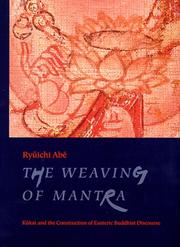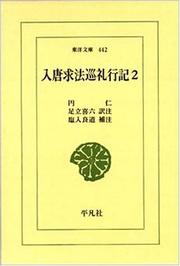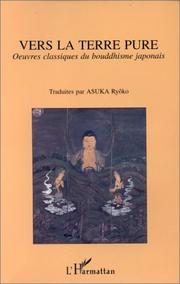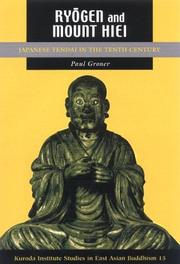| Listing 1 - 9 of 9 |
Sort by
|

ISBN: 0231112866 0231112874 9780231112864 9780231112871 Year: 1999 Publisher: New York Columbia university press
Abstract | Keywords | Export | Availability | Bookmark
 Loading...
Loading...Choose an application
- Reference Manager
- EndNote
- RefWorks (Direct export to RefWorks)
"The Buddhist priest Kukai (774-835) is credited with the introduction and formal establishment of tantric - or esoteric - Buddhism in early ninth-century Japan and the founding of the Shingon school. In The Weaving of Mantra, author Ryuichi Abe examines this important religious figure and his profound influence on Japanese culture. Abe contends that the importance of Kukai's establishment of esoteric Buddhism lay not in the foundation of the Shingon sect but in his creation of a general theory of language grounded in the ritual speech of mantra." "The Weaving of Mantra embeds Kukai within the fabric of political and social life in ninth-century Japan and explains how esoteric Buddhism played a critical role in many societal changes in Japan - from the growth of monasteries into major feudal powers to the formation of the native phonetic alphabet, kana. As Abe illustrates, Kukai's writings and the new type of discourse they spawned also marked Japan's transition from the ancient order to the medieval world, replacing Confucianism as the ideology of the state."--BOOK JACKET.
Shingon (Sect) --- Doctrines. --- Esoterik. --- Mantra. --- Sectes bouddhiques --- Shingon (secte). --- Kūkai, --- Kūkai. --- Studies. --- Japon --- Religion --- J1876 --- J1800.30 --- Japan: Religion -- Buddhism -- Shingon --- Japan: Religion -- Buddhism -- history -- Heian period (794-1185) --- Shingon-Schule --- Kūkai, --- Kūkai --- 774-835 --- Doctrines

Abstract | Keywords | Export | Availability | Bookmark
 Loading...
Loading...Choose an application
- Reference Manager
- EndNote
- RefWorks (Direct export to RefWorks)
Tendai priests --- Ennin, --- Travel --- China --- Description and travel. --- J1873 --- J1800.30 --- S03/0200 --- Japan: Religion -- Buddhism -- Tendai --- Japan: Religion -- Buddhism -- history -- Heian period (794-1185) --- China: Geography, description and travel--Historical geography and early travels: general and before 1200

ISBN: 2738423132 9782738423139 Year: 1993 Publisher: Paris L'Harmattan
Abstract | Keywords | Export | Availability | Bookmark
 Loading...
Loading...Choose an application
- Reference Manager
- EndNote
- RefWorks (Direct export to RefWorks)

ISBN: 0824822609 9780824822606 Year: 2002 Volume: 15 Publisher: Honolulu University of Hawaii press
Abstract | Keywords | Export | Availability | Bookmark
 Loading...
Loading...Choose an application
- Reference Manager
- EndNote
- RefWorks (Direct export to RefWorks)
Tendai (Sect) --- Priests, Tendai --- History. --- J1873 --- J1800.30 --- J2284.30 --- -Tendai (Sect) --- -Priests, Tendai --- Buddhist priests --- Japan: Religion -- Buddhism -- Tendai --- Japan: Religion -- Buddhism -- history -- Heian period (794-1185) --- Japan: Genealogy and biography -- biographies -- Heian period (794-1185) --- History --- Clergy --- Ryogen --- Tendai priests --- Ryōgen, --- Gansan Daishi, --- Jie Daishi, --- Ganzan Daishi, --- 良源, --- Tendai (Sect) - History. --- Priests, Tendai - Japan - Biography. --- Ryōgen
Book
ISBN: 9780824839864 Year: 2015 Publisher: Honolulu University of Hawaiʻi Press
Abstract | Keywords | Export | Availability | Bookmark
 Loading...
Loading...Choose an application
- Reference Manager
- EndNote
- RefWorks (Direct export to RefWorks)
Buddhism --- Buddhism and state --- History --- Rituals. --- History. --- Japan --- Politics and government --- Rituals --- Lamaism and state --- State and Buddhism --- State, The --- Buddha and Buddhism --- Lamaism --- Ris-med (Lamaism) --- Religions --- J1800.30 --- J4600.30 --- J1864 --- Japan: Religion -- Buddhism -- history -- Heian period (794-1185) --- Japan: Politics and law -- history -- Heian period (794-1185) --- Japan: Religion -- Buddhism -- relation with state and politics
Book
ISBN: 9789004196018 Year: 2012 Publisher: Leiden Boston Brill
Abstract | Keywords | Export | Availability | Bookmark
 Loading...
Loading...Choose an application
- Reference Manager
- EndNote
- RefWorks (Direct export to RefWorks)
Bhaiṣajyaguru (Buddhist deity) --- Buddhist sculpture --- Sculpture, Japanese --- J1800.30 --- J1830 --- J1895 --- Healing Buddha (Buddhist deity) --- Sman-bla (Buddhist deity) --- Yakushi Nyorai (Buddhist deity) --- Yao-shih-fo (Buddhist deity) --- Buddhist gods --- Cult --- Japan: Religion -- Buddhism -- history -- Heian period (794-1185) --- Japan: Religion -- Buddhism -- deities --- Japan: Religion -- Buddhism -- art
Book
ISBN: 9781929280483 9781929280476 Year: 2008 Publisher: Ann Arbor University of Michigan. Center for Japanese studies
Abstract | Keywords | Export | Availability | Bookmark
 Loading...
Loading...Choose an application
- Reference Manager
- EndNote
- RefWorks (Direct export to RefWorks)
J5923 --- J5700 --- J5500.30 --- J1890 --- J1800.30 --- J2284.30 --- Buddhist literature, Japanese --- -Japanese literature --- -Women authors in literature --- Women authors, Japanese --- -Japanese women authors --- Authors, Japanese --- Japanese Buddhist literature --- Japanese literature --- Japan: Literature -- premodern fiction and prose -- Heian period (794-1185) --- Japan: Literature -- poetry in general --- Japan: Literature -- history and criticism -- Heian period (794-1185) --- Japan: Religion -- Buddhism -- literature --- Japan: Religion -- Buddhism -- history -- Heian period (794-1185) --- Japan: Genealogy and biography -- biographies -- Heian period (794-1185) --- History and criticism. --- History and criticism --- Heian period, 794-1185 --- -Fiction --- Women authors in literature. --- Fiction. --- -Japan: Literature -- premodern fiction and prose -- Heian period (794-1185) --- Fiction --- Women authors in literature --- Japanese women authors --- Izumi Shikibu
Book
ISBN: 9780231543316 023154331X 9780231170123 0231170122 9780231170130 0231170130 0824869702 9780824869700 9780824861148 9780824834166 0824861140 082483416X Year: 2017 Publisher: New York
Abstract | Keywords | Export | Availability | Bookmark
 Loading...
Loading...Choose an application
- Reference Manager
- EndNote
- RefWorks (Direct export to RefWorks)
"This is a study of visual and textual images of the mythical creature tengu from the late Heian (897-1185) to the late Kamakura (1185-1333) periods. Popularly depicted as half-bird, half-human creatures with beaks or long noses, wings, and human bodies, tengu today are commonly seen as guardian spirits associated with the mountain ascetics known as yamabushi. In the medieval period, however, the character of tengu most often had a darker, more malevolent aspect. Haruko Wakabashi focuses in this study particularly on tengu as manifestations of the Buddhist concept of Māra (or ma), the personification of evil in the form of the passions and desires that are obstacles to enlightenment. Her larger aim is to investigate the use of evil in the rhetoric of Buddhist institutions of medieval Japan. Through a close examination of tengu that appear in various forms and contexts, Wakabayashi considers the functions of a discourse on evil as defined by the Buddhist clergy to justify their position and marginalize others.Early chapters discuss Buddhist appropriations of tengu during the late twelfth and thirteenth centuries in relation to the concept of ma. Multiple interpretations of ma developed in response to changes in society and challenges to the Buddhist community, which recruited tengu in its efforts to legitimize its institutions. The highlight of the work discusses in detail the thirteenth-century narrative scroll Tengu zōshi (also known as the Shichi Tengu-e, or the Seven Tengu Scrolls), in which monks from prominent temples in Nara and Kyoto and leaders of "new" Buddhist sects (Pure Land and Zen) are depicted as tengu. Through a close analysis of the Tengu zōshi's pictures and text, the author reveals one aspect of the critique against Kamakura Buddhism and how tengu images were used to express this in the late thirteenth century. She concludes with a reexamination of the meaning of tengu and a discussion of how ma was essentially socially constructed not only to explain the problems that plague this world, but also to justify the existence of an institution that depended on the presence of evil for its survival.Drawing on a wide range of primary sources, Wakabayashi provides a thoughtful and innovative analysis of history and religion through art. The Seven Tengu Scrolls will therefore appeal to those with an interest in Japanese art, history, and religion, as well as in interdisciplinary approaches to socio-cultural history." -- Publisher's description.
Health care reform --- Medical policy --- United States. --- United States --- Buddhism --- Good and evil --- Tengu --- J1723.80 --- J1730 --- J1800.30 --- J1800.40 --- J1809 --- Long-nosed goblin --- Tengu (Japanese goblin) --- Fairies --- Ghouls and ogres --- History --- Religious aspects --- Japan: Religion in general -- demonology --- Japan: Religion in general -- mythology --- Japan: Religion -- Buddhism -- history -- Heian period (794-1185) --- Japan: Religion -- Buddhism -- history -- Kamakura period, Yoshino (1185-1392) and Chūsei in general (1185-1600) --- Japan: Religion -- Buddhism -- theory, methodology and philosophy --- Tengu no sōshi. --- Tengu sōshi --- Tengu. --- Buddhism.
Book
ISBN: 3891296908 Year: 1998 Publisher: München Iudicium
Abstract | Keywords | Export | Availability | Bookmark
 Loading...
Loading...Choose an application
- Reference Manager
- EndNote
- RefWorks (Direct export to RefWorks)
Shinto --- Prayers and devotions --- History and criticism. --- Religions --- Nakatomi no harae kunkai. --- Nakatomi no harae. --- Nakatomi no harai --- Ōbarai no kotoba --- J1948.10 --- J1970.30 --- J1954.20 --- J1954.10 --- J1876 --- J1861 --- J1800.30 --- Japan: Religion -- Shintō -- rituals, practices, festivals (matsuri) -- practice, prayer and offering --- Japan: Religion -- Shintō -- history -- Heian period (794-1185) --- Japan: Religion -- Shintō -- sects -- Ise shintō (Watarai shintō, Jingūkyō) --- Japan: Religion -- Shintō -- sects -- Buddhist Shintō --- Japan: Religion -- Buddhism -- Shingon --- Japan: Religion -- Buddhism -- relation with Shintō (and Shinbutsu) --- Japan: Religion -- Buddhism -- history -- Heian period (794-1185) --- J1910.30 --- Nakatomi harae kunge --- Nakatomi no harai kunkai --- Nakatomi no harae ryōbushū --- J1913.10 --- J1913.20 --- Japan: Religion -- Shintō -- sects and schools -- traditional -- Buddhist shintō --- Japan: Religion -- Shintō -- sects and schools -- traditional -- Ise shintō, Watarai shintō --- J1915.20 --- Japan: Religion -- Shintō -- rituals and practices -- worship, ceremony, offering --- Prayers and devotions&delete& --- History and criticism
| Listing 1 - 9 of 9 |
Sort by
|

 Search
Search Feedback
Feedback About
About Help
Help News
News